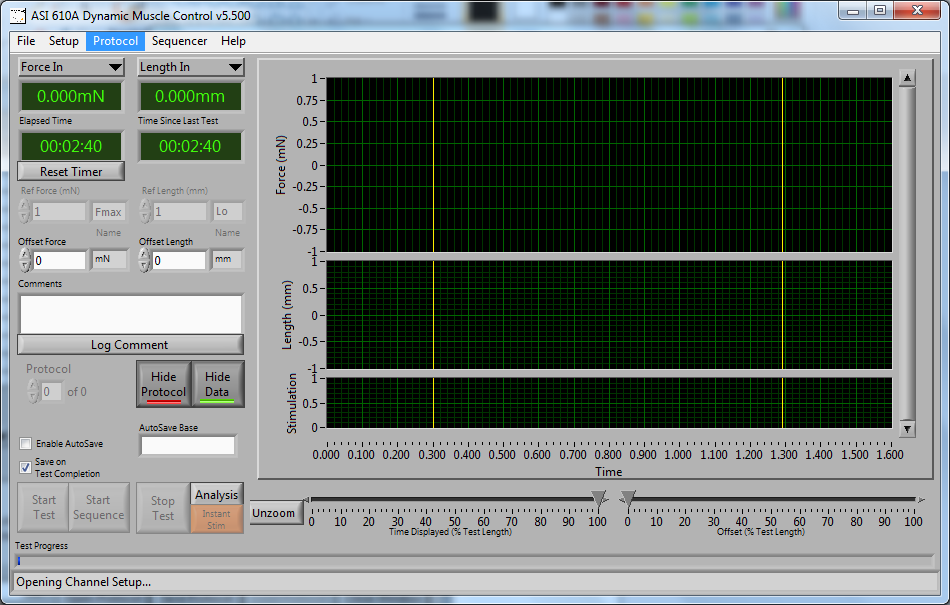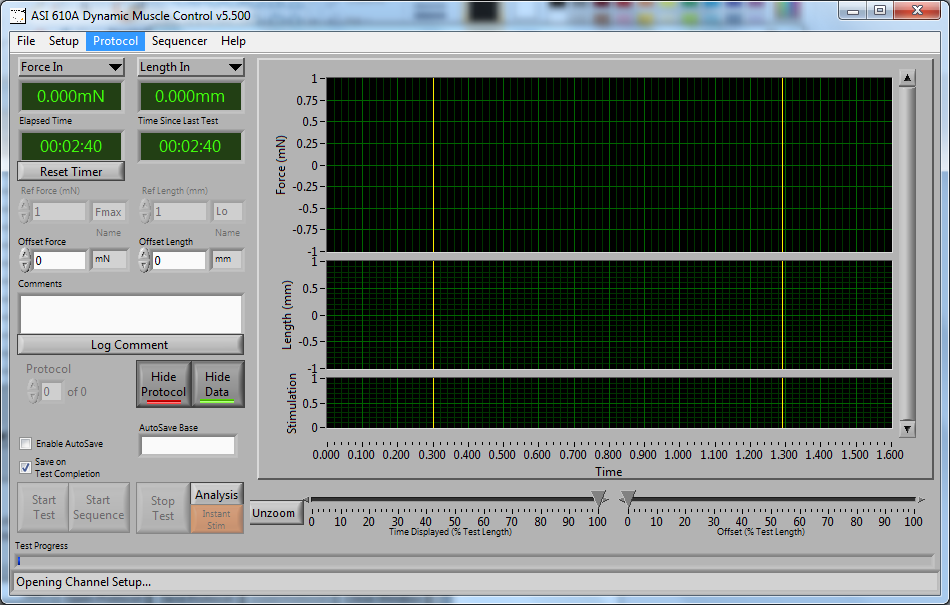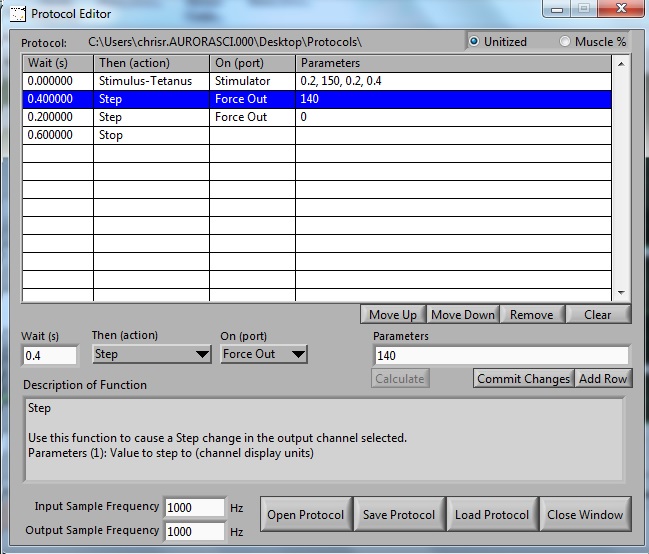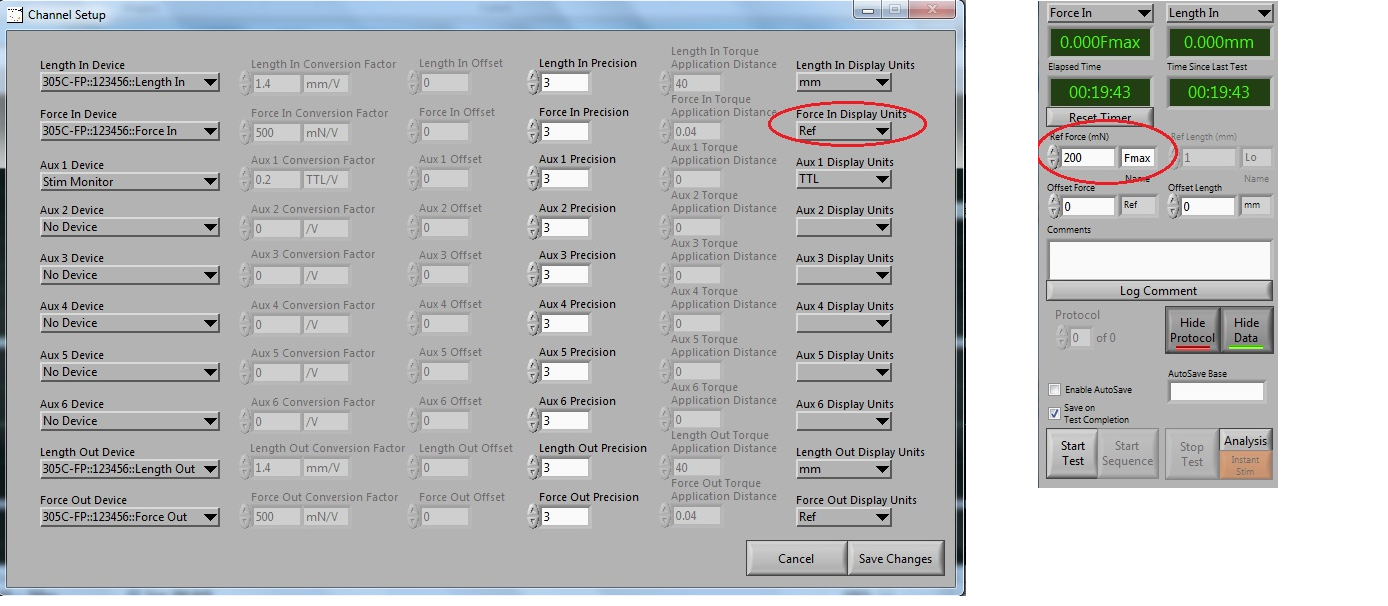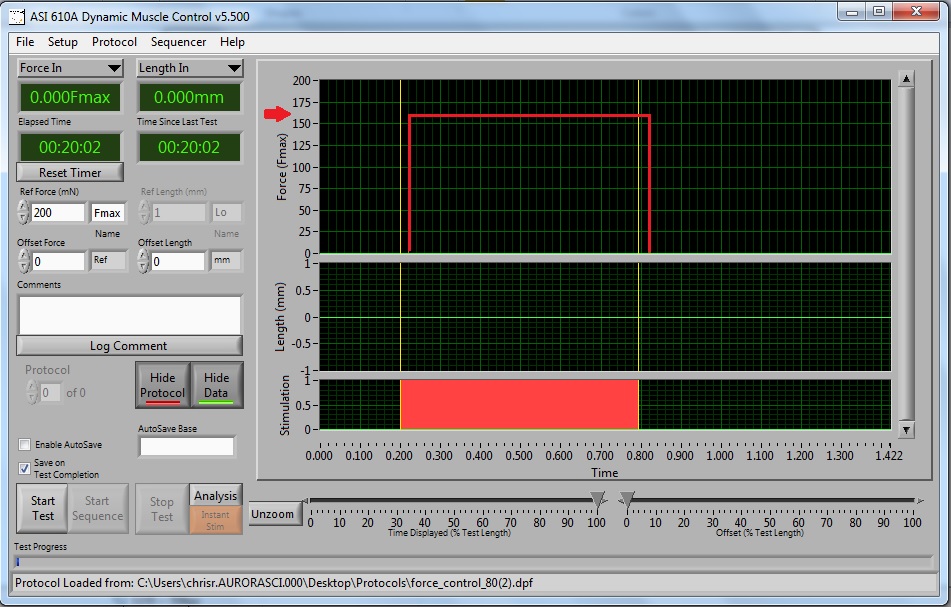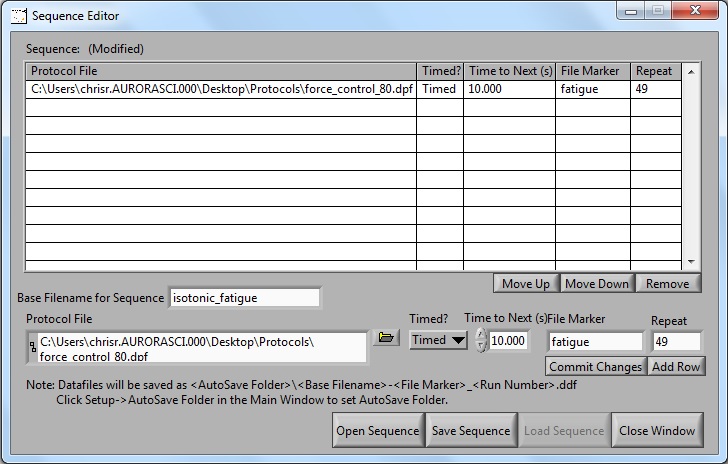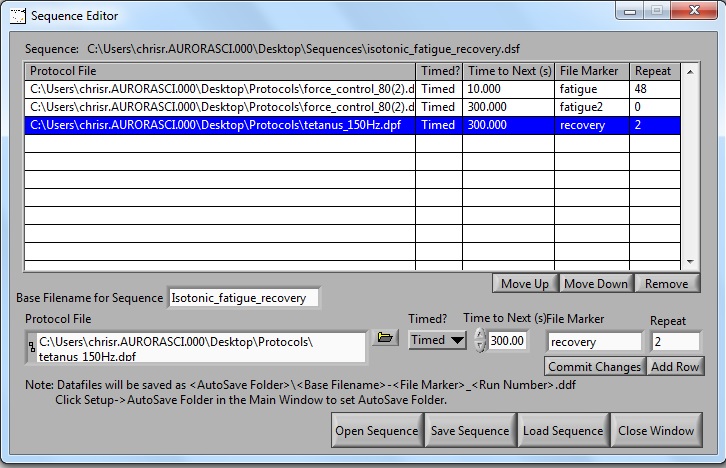Are you wondering how to accurately model human exercise?
In this third and final installment of our series of blogs, “How to Write Basic Protocols in DMC,” we will outline how to write basic force control protocols to perform isotonic contractions. Many researchers employ these types of experiments to accurately model human exercise since these protocols more closely model real world exercise and work as opposed to isometric protocols.
If you’d like to learn how to write and perform a basic twitch or tetanus protocol, or get an overview of key terms you’ll encounter using 615A Dynamic Muscle Control and Analysis Software, check out our first installment, “How to Write Basic Protocols in DMC – Isometric,” for detailed step-by-step instructions.
Jump to:
Absolute
Percent Fmax
Fatigue
Isotonic
Although isometric contractions are widely used to measure maximal force production and assess muscle performance, the information they provide about the muscle’s performance is limited. Unlike isometric contractions which hold muscle length constant, an isotonic contraction results in a constant force produced (i.e. constant load) while the muscle shortens to maintain that force.
Performing multiple maximal contractions under isometric conditions while working with isolated muscle, does not accurately model human exercise. Humans can not run sustained at full speed for several minutes, nor do they lift a maximal weight many times during a workout. The majority of human exercise occurs at some percentage of these maximums for a sustained period.
Additionally, controlling force to a certain percentage of the muscle’s maximum allows you to measure valuable parameters such as shortening velocity as well as establishing force-velocity and power-velocity relationships with your model.
Therefore, by controlling the force exerted by your animal model or muscle preparation to a percentage of its maximum or to a specific amount of force a more physiologically relevant experimental model of exercise can be realized.
By using similar models, any researcher can begin to test and compare the effects of force controlled exercise on factors such as disease phenotype, disease progression, molecular mechanisms and muscle mechanics, among others.
Note: if you are using our 300C series Dual-Mode lever systems, you must turn the force offset knob on the front panel of the control box to ‘0’ to allow the software to control force properly.
To begin, open the protocol editor found at the top of the main window of Dynamic Muscle Control (DMC).
Figure 1. Main window of Dynamic Muscle Control software highlighting the protocol editor tab.
Absolute
Force can be controlled using DMC in two basic ways, either by controlling to an absolute load (i.e. 140mN) or to a percentage of the maximum force produced by the muscle or animal (i.e. 80% of Fmax). Here we will show you how to write a protocol to control force to an absolute value.
The benefit of controlling to a specific force value is that you can model things like gait in the animal where you wish to control the force output at varying points of the movement while measuring shortening velocity and determining force-velocity and power-velocity relationships. In addition, using this type of protocol allows you to apply the same paradigm within and between animal models so that each an every animal tested undergoes the same experimental parameters.
Key Terms:
‘Unitized’ – change in ‘Force Out’ value in SI units (i.e. mN or mN-m)
Muscle % – change in ‘Force Out’ value as percentage of a reference value (e.g. 80% of Fmax)
‘Step’ – immediate change in force value
‘Value to step to’ – value you wish to immediately change force to (e.g. 140mN or 80% Fmax)Below are the steps required to write a basic isotonic protocol:
- enter 0 for ‘Wait’
- choose ‘Stimulus – Tetanus’ from action drop down menu
- in the parameters box, enter the following, 0.2, 150, 0.2, 0.4
- select ‘Add Row’
- enter 0.4 for ‘Wait’
- choose ‘Step’ from action menu, select ‘Force Out’ from ‘On (port)’ menu
- in the parameters box, enter the following: 140
- select ‘Add Row’
- enter 0.2 for ‘Wait’
- choose ‘Step’ from action menu, select ‘Force Out’ from ‘On (port)’ menu
- in the parameters box, enter the following: 0 (muscle passively returns to Fo)
- select ‘Add Row’
- enter a stop command, with a ‘Wait’ of 0.6s and select ‘Add Row’
- save protocol (e.g. force_control_140mN)
Figure 2. An example of an isotonic contraction protocol controlling force to 140mN, written using the protocol editor.
Figure 3. DMA software screen shot illustrating a series of isotonic contractions (plateaus in upper force trace) using the dual-mode lever system (e.g. force control of muscle preparation to 140mN, 90mN and 120mN respectively). Data courtesy of Granzier Lab, University of Arizona.Note: ensure you remove the values in the parameters box prior to adding a stop command.
Percent Fmax
In contrast to controlling contractile force to an absolute value, you can utilize our software and dual-mode lever system to control the amount of force the animal produces as a percentage of a reference value. This reference value is determined by first finding the maximal isometric tetanic force produced by your animal or muscle preparation. This maximum value is deemed to be ‘Fmax.’ If you need a refresher on writing an isometric tetanus protocol, have a look at our first installment “How to Write Basic Protocols in DMC – Isometric.”
Once you have obtained Fmax you can then utilize the software to control the transducer to some percentage of maximum force. To do this, open the channel setup window by selecting ‘Setup’ in the main DMC window and then open the ‘Channel Setup’ window as seen in Figure 4. Go to the drop down menu on the right hand side of the ‘Force in Device’ and select Ref from the list. Click ‘Save Changes’ at the bottom of the window.
You’ll now notice that the ‘Ref Force (mN)’ box on the main DMC window can be edited (Figure 4). In the box beside Fmax, enter the maximum tetanic force value you acquired previously (in mN).
Note: Each time you test a new animal or muscle you must enter a new Fmax into this field.
Figure 4. Left: Screenshot of the channel setup module whereby the length and force display units can be changed. Force display units have been changed to Ref denoting reference units (i.e. Fmax; circled in red). Right: Main DMC channel display showing units force and length to be Fmax and mm respectively. Note the Ref force (i.e. Fmax) is entered as 200mN (circled in red).
You are now ready to write an isotonic protocol using reference units.Open the protocol editor and follow the steps below to write a basic isotonic protocol using a percentage of Fmax:
- Select ‘Muscle %’ (circled in red)
- enter 0 for ‘Wait’
- choose ‘Stimulus – Tetanus’ from action drop down menu
- in the parameters box, enter the following, 0.2, 150, 0.2, 0.6
- select ‘Add Row’
- enter 0.22 for ‘Wait’
- choose ‘Step’ from action menu, select ‘Force Out’ from ‘On (port)’ menu
- in the parameters box, enter 0.8 (i.e. 80% of Fmax)
- select ‘Add Row’
- enter 0.6 for ‘Wait’
- choose ‘Step’ from action menu, select ‘Force Out’ from ‘On (port)’ menu
- in the parameters box, enter 0
- select ‘Add Row’
- enter a stop command, with a ‘Wait’ of 0.6s and select ‘Add Row’
- save protocol (e.g. force_control_80%)
Figure 5. An example of an isotonic contraction protocol controlling force to 80% of Fmax written using the protocol editor. Note the radial button for muscle % circled in red.
Figure 6. Depiction of an isotonic contraction protocol in DMC controlling muscle force to 80% of Fmax (i.e. 160mN).
Fatigue
The advantage of using isotonic contractions to model exercise and fatigue is put simply, when we exercise, we lift, push and pull at a sub-maximal threshold. Therefore, isometric and even concentric/eccentric contractions alone do not model exercise and fatigue as well as an isotonic contraction.
The overwhelming majority of fatigue protocols found in the literature employ numerous isometric contractions to induce muscle fatigue. However, this type of muscle fatigue does not correspond to what is normally seen when we exercise, which results from a combination of concentric and eccentric contractions to maintain constant load. Therefore repeated submaximal contractions under constant load better replicates real world exercise.
Now that you have your isotonic protocol written, you’re ready to write a fatigue sequence utilizing the percent of Fmax isotonic protocol. To do this, open the sequence editor by clicking on ‘Sequence’ at the top of the main DMC window.
- open a protocol by clicking on the folder icon, select your isotonic protocol (i.e. force_control_80%)
- the sequencer allows you to time when your next protocol will be executed, it is recommended for this particular experiment that you enter a ‘Time to Next’ of 10s
- in the ‘File Marker’ box, enter a unique tag to associate the data with a specific protocol (e.g. fatigue)
- enter 49 repeats (50 total contractions) to incur sufficient muscle fatigue
- click ‘Add Row’
- once you’ve added the protocol file, enter a ‘Base Filename for Sequence’ to associate your data with this particular sequence. For example, we’ve entered isotonic_fatigue.
- save sequence (e.g. Isotonic_Fatigue)
Figure 7. An example of an isotonic fatigue sequence consisting of 50 contractions with 10 seconds between each, written using the sequence editor.
In order to measure fatigue recovery many researchers run a single isometric tetanus at various time points following the last isotonic contraction. This can be done by manually running a single isometric tetanus protocol at specified time points (e.g. 5, 10, 15 minutes) following the fatigue sequence or by building it in to the sequence using the editor.
To add a recovery tetanus into your isotonic fatigue sequence:
- select row, change the number of repeats to 48 and click ‘Commit Changes’
- select row, change the ‘Time to Next’ to be 300s (i.e. 5 minutes) and the number of repeats to 0
- enter a unique ‘File Marker’ (e.g. fatigue2), ‘Add Row’
- click the folder icon and open your 150Hz tetanus protocol
- enter a ‘Time to Next’ of 300s if you wish to perform a 5 minute recovery tetanus, if you do not wish to repeat enter 0 for delay time between repeats
- enter number of repeats desired (e.g. 2 for 5, 10 and 15 minute recovery tetanus)
- enter unique ‘File Marker’ (e.g. recovery), ‘Add Row’
- enter ‘Base Filename for Sequence’ (e.g. isotonic_fatigue_recovery)
- ‘Save Sequence’ (e.g. fatigue_recovery)
Figure 8. An example of an isotonic fatigue sequence consisting of 50 contractions with 10 seconds between each followed by 3 recovery tetani every 5 minutes, written using the sequence editor.
Now that you have the ability to write any number of muscle contraction protocols, you can begin to use the full power of the Dual-Mode Lever System by combining isometric, concentric, eccentric and isotonic contractions to fully characterize muscle function.
If you’d like to learn how to control muscle length using reference units as opposed to unitized, check out our previous blog:
Control Muscle Length with DMC Software Using Reference Units
Published Examples
Interested in how isotonic protocols are being employed by muscle physiologists? Here are a few published examples:
The Effects of K+ Channel Blockade on Eccentric and Isotonic Twitch and Fatiguing Contractions in situ
Diaphragm and ventilatory dysfunction during cancer cachexia
Stuck in gear: age-related loss of variable gearing in skeletal muscle

